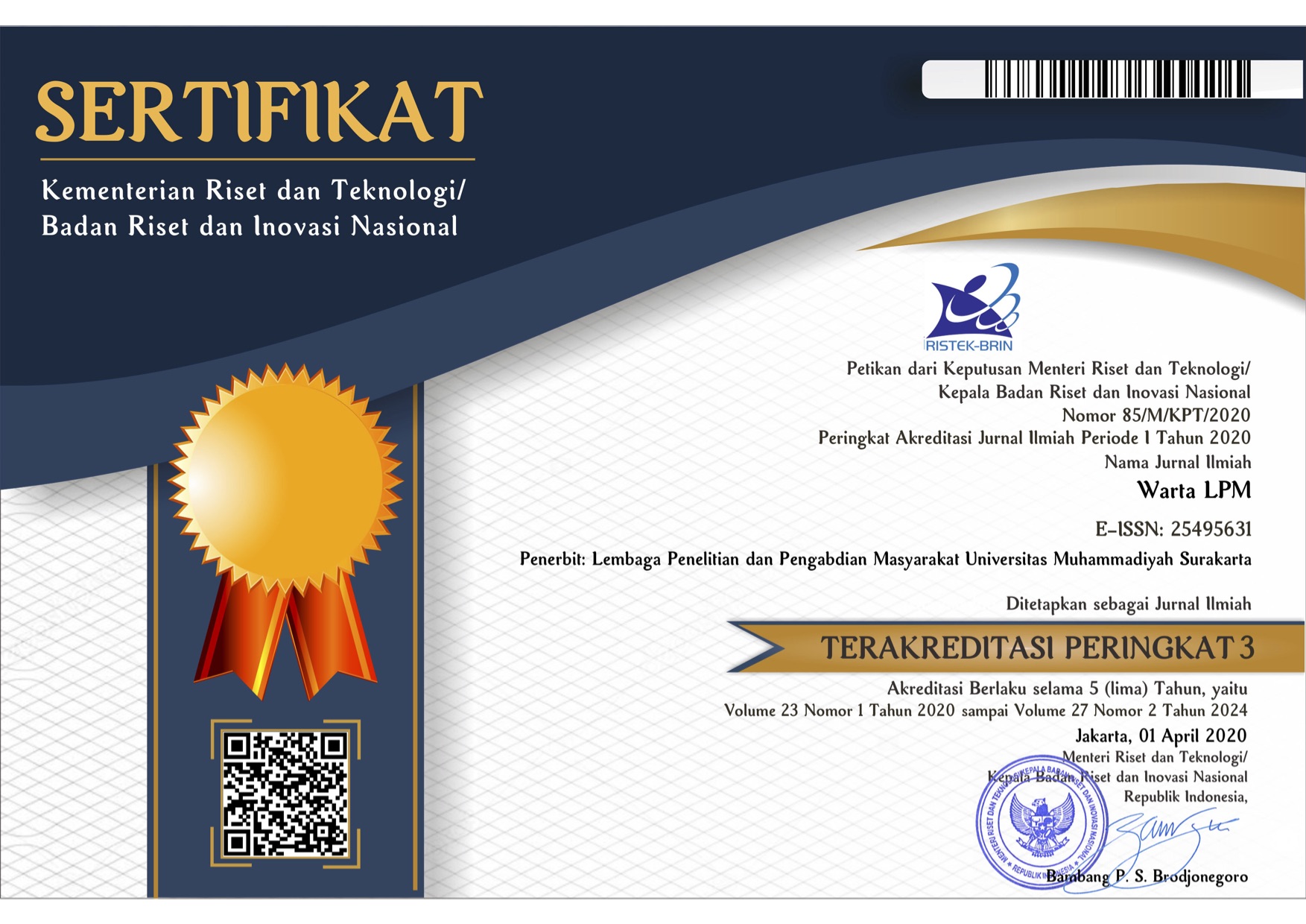Mitigation of Halal Risk in the Production Process of Processing Beef Using the FMEA Method in UMKM Dendeng Sapi Asri
Hafidh Munawir(1*), Fatimah Tri Astuti(2), Eko Setiawan(3), Mila Faila Sufa(4)(1) Industrial Engineering Department, Faculty of Engineering, Universitas Muhammadiyah Surakarta
(2) Faculty of Engineering, Universitas Muhammadiyah Surakarta
(3) Faculty of Engineering, Universitas Muhammadiyah Surakarta
(4) Faculty of Engineering, Universitas Muhammadiyah Surakarta
(*) Corresponding Author
Abstract
Purpose : This research was conducted to identify the risk of being halal that occurs in the production process, calculate the level of halal risk, and provide suggestions for improvements to reduce the risk of the halalness of a production process.
Methodology : This study uses the FMEA method which aims to analyze the risk of events that may occur in the production process and the AHP method is used to determine mitigation priorities that can be applied as a proposed improvement in UMKM Dendeng Sapi Asri.
Results : The results of risk identification found that there were 19 halal risk and five priority risks, namely raw materials that are not registered with LPPOM MUI, mismatches of raw materials received, because animal dung falls from above during drying of meat, the production process has not used work SOPs for each stage of the process. halal, and the shipping process that is potentially contaminated with unclean.
Applications/Originality/Value : At the end of the study, suggestions for improvement were given to reduce the risk of halalness, namely overseeing the implementation of work SOP for employees, and followed by routine cleaning, implementing work SOP, establishing cooperation, checking products before sending, establishing communication, providing training to workers, and positioning drying tools in an appropriate place.
Full Text:
PDFReferences
Alfazah,D,A, Ridwan, A,Y, & Yulianti, Femi.(2019). Perancangan Dashboard Monitoring Ketahanan Pangan dan Mitigasi Risiko Pengadaan Komoditas Beras Menggunakan Failure Mode and Effect Analysis (FMEA) dan Analytical Hierarchy Process (AHP) di Bulog Subdivre Bandung. E-Proceeding of Engineering. 6(2): 6750.
Ali,M,H, Tan,K,H, Makhbul,Z,M. (2015). Mitigating halal food integrity risk through supply chain integration. Asia Pacific Industrial Engineering and Management System.
Ali, Moh. Helmi. (2014). Extenuating Food Integrity Risk Through Supply Chain Integration: The Case of Halal Food. Industrial Engineering & Management Systems. 13(2):154-162.
Andiyanto,S, Sutrisno,A, Punuhsingon,C. (2017). Penerapan Metode Fmea (Failure Mode and Effect Analysis) untuk Kuantifikasi Dan Pencegahan Resiko Akibat Terjadinya Lean Waste. Jurnal Online Poros Teknik Mesin, 6(1).
Chow, W. S., C. N. Madu, C-H. Kuei, M. H. Lu, C. Lin, and H. Tseng. (2008). Supply Chain Management in The US and Taiwan: An Empirical Study. OMEGA: The International Journal of Management Science 36 (5):665-679.
Herjanto, E. (2009). Sains Manajemen:Analisis Kuantitatif Untuk Pengambilan Keputusan. Penerbit Grasindo. Jakarta.
Indrajit, Richardus Eko & Djokopranoto, Richardus. (2002). Konsep Manajemen Supply Chain: Cara Baru Memandang Mata Rantai Penyediaan Barang. Jakarta: PT. Gramedia Widiarsarana Indonesia.
Mahidin,N, Saifudin,A,M, Othman,S,N. (2017). Halal Food Logistics:The Challenges Among Food & Baverages Small and Medium Sizes Manufactures. Int.J.Sup.Chain.Magt, 6(3).
Maman Ujang, Mahbubi Akhmad, dan J. F. (2015). Halal Risk Mitigation in the Australian-Indonesian Red Meat Supply Chain. Journal of Islamic Marketing. Vol. 9, Issue 1.
Maman,U, Mahbubi,A, Jie,F. (2017). Strategic Planning to Control Halal Risk in Indonesian Beef Supply Chain. International Business Management, 11 (6):1246-1253.
Mansur,A, Farida,A, Albab,M,U. (2017). Operation Risk Mitigation On Halal Meat Supply Chain Management. IOP Conference Series: Materials Science and Engineering 215, 012027.
Marimin. (2008). Teknik dan Aplikasi Pengambilan Keputusan Kriteria Majemuk. Jakarta: Grasindo.
Marzuki, S.Z.S.; Hall, C.M.; Ballantine, P.W. (2014). Measurement of restaurant manager expectations toward halal certification using factor and cluster analysis. Procedia - Social and Behavioral Sciences, Vol. 121, pp: 291 – 303.
Nugrahanti,F, Wisnubhadra,I, & Julianto,E. (2014). Analisa Perancangan Sistem Informasi Managemen Proses produksi (Supply Chain) pada Perusahaan Pembuat Peralatan Tambang (Studi Kasus PT. Refindo Inti Selaras Indonesia). Seminar Nasional Teknologi Informasi dan Komunikasi 2014 (SENTIKA 2014). ISSN: 2089-9813.
Pujawan, I., N., dan Mahendrawathi. (2010). Supply Chain Management, Edisi Kedua, Guna Widya, Surabaya.
Ridwan,A, Trenggonowati,D,L, Parida,V. (2019). Usulan Mitigasi Risiko Proses produksiHalal Pada IKM Tahu Bandung Sutra Menggunakan Metode House of Risk. Journal Industrial Services, 5(1).
Salman, F.; Siddiqui, K. (2011). An exploratory study for measuring consumers’ awareness and perceptions towards halal food in Pakistan. Interdisciplinary Journal of Contemporary Research in Business, Vol. 3, pp: 639 – 652.
Ulfah.M. (2016). Analisis dan Perbaikan Manajemen Risiko Proses Produksi Gula Rafinasi dengan Pendekatan House of Risk. Jurnal Teknologi Industri Pertanian, 26(1), 87–103.
Vanany,Iwan & Maarif, Ghoffar Albab. (2018). Application of Multi-Based Quality Function Deployment (QFD) Model to Improve Halal Meat Industry. Journal of Islamic Marketing.
Wahyuni, Hana, Vannay, Iwan, Ciptomulyono, Udisubakti. (2019). Food Savety and Halal Food in the Supply Chain: Review and Bibliometric Analysis. Journal of Industrial Engineering and Management (JIEM), 12(2): 373-391.
Yaacob,T,Z, Jaafar,H,S, Rahman,F,A. (2016). A Review Of Regulatory Framework For Halal Meat Supply Chain: The Case Of Halal Meat Based Food Products in Malaysia. J.Appl. Environ. Biol. Sci., 6(9S) 14-21.
Yahya,H, Samicho,Z, Azmi,A,F,M,N. 2016. A Review on Application of Halalan-Toyyiban Risk Management Plan (HTRMP) and Frozen Food Chain during Warehousing Activities for Maintaining Halal, Safety, and Quality. J.Appl. Environ. Biol. Sci.,6(11)96-102.
Article Metrics
Abstract view(s): 681 time(s)PDF: 519 time(s)
Refbacks
- There are currently no refbacks.









